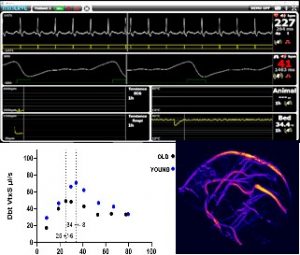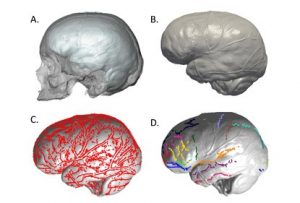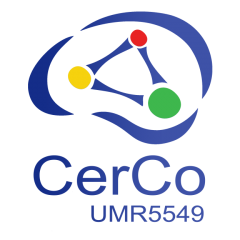
Equipe PreSage
caroline.fonta@cnrs.fr
Tél : 05 62 74 61 51
![]() My main research project aims to isolate markers, or combinations of markers, to characterise and predict brain ageing in an NHP model (marmoset monkey)(1). These markers will mainly be derived from non-invasive brain
My main research project aims to isolate markers, or combinations of markers, to characterise and predict brain ageing in an NHP model (marmoset monkey)(1). These markers will mainly be derived from non-invasive brain imaging explorations, associated with cognitive performance measurements (collaboration Pascal Girard, CerCo). In parallel to brain parenchyma changes, my project will analyze how fluid networks can find their place in the repertoire of markers indicating the quality of ageing.Morphometric and functional parameters of hemo- and hydro-dynamics networks (2) will feed numerical simulations and test models developed by mathematicians and fluid mechanics (3, 4, 5). These studies are carried out parallel in humans (6)(ANR Hanuman)
imaging explorations, associated with cognitive performance measurements (collaboration Pascal Girard, CerCo). In parallel to brain parenchyma changes, my project will analyze how fluid networks can find their place in the repertoire of markers indicating the quality of ageing.Morphometric and functional parameters of hemo- and hydro-dynamics networks (2) will feed numerical simulations and test models developed by mathematicians and fluid mechanics (3, 4, 5). These studies are carried out parallel in humans (6)(ANR Hanuman)
 I also address TNAP’s functions in the resolution of brain inflammation using in vitro and in vivo mouse models. Because this enzyme regulates ATP levels, it is likely involved in multiple cerebral pathologies (e.g., epilepsy, Alzheimer’s disease). We developed a transdisciplinary approach to map in time and space extracellular ATP levels (7, 8) and to analyse metabolomic (7) as well as biochemical and
I also address TNAP’s functions in the resolution of brain inflammation using in vitro and in vivo mouse models. Because this enzyme regulates ATP levels, it is likely involved in multiple cerebral pathologies (e.g., epilepsy, Alzheimer’s disease). We developed a transdisciplinary approach to map in time and space extracellular ATP levels (7, 8) and to analyse metabolomic (7) as well as biochemical and  transcriptomic consequences (9) of acute or chronic systemic inflammation while controlling TNAP level. Due to the ubiquitous expression of TNAP and its essential role in mineralization, our analysis integrates several tissues (brain, liver, bone, blood) (10). I collaborate with Lionel Nowak (CerCo) to assess the effects of TNAP inhibition on synaptic transmission.
transcriptomic consequences (9) of acute or chronic systemic inflammation while controlling TNAP level. Due to the ubiquitous expression of TNAP and its essential role in mineralization, our analysis integrates several tissues (brain, liver, bone, blood) (10). I collaborate with Lionel Nowak (CerCo) to assess the effects of TNAP inhibition on synaptic transmission.

I contribute to a project in Paleoneurobiology developed by Amélie Baudet, Chaire Professeur Junior, PAVEVOPRIM, UMR7262, Poitiers. Grooves visible on endocranial surfaces are relevant markers of functional areas in the human brain. Atlas of these sulci and their probability maps (11) can document the variation in sulcus patterns in the cerebral cortex. Such atlases from human and non-human primate endocrania will be used to compare hominin fossil skull samples and thus analyse the evolution of the cerebral cortex. Projet PHC PROTEA.
Main external collaborators
- Marcello Rosa (Department of Physiology, Monash University, Australia)
- Franck Desmoulin (Tonic INSERM 1214, Toulouse)
- Jean Pierre Raymond, Michel Fournié (Institute of Mathematics, Toulouse)
- Moktar Zagzoule, Patricia Cathalifaud, (Institute of Fluid Mechanics, Toulouse)
- Stéphanie Salmon, Nicolas Passat (University of Reims)
- Olivier Baledent (Chimere, University of Amiens)
- Véronique Gilard, Fabrice Collin, Stéphane Balayssac (IMRCP, University of Toulouse)
- Robert Mauricot (CEMES, Toulouse)
- David Magne (ICBMS, University of Lyon)
- Jose Luis Millan (Burham Institute, La Jolla, CA, USA
- Laurent Risser (Institute of Mathematics, Toulouse)
Recent representative publications
⦁ Gleizes M, Fonta C*, Nowak L*. (2022) Inhibition of ectonucleotidases has paradoxical effects on synaptic transmission in the mouse cortex. J Neurochem 160:305-324. doi: 10.1111/jnc.15558.
⦁ Beaudet A, Fonta C. (2020) Aux origines de l’humanité : retracer les grandes étapes de notre évolution biologique et culturelle à partir de l’étude du cerveau de nos ancêtres. Intellectica, 2020/2, Emergence et évolution de la Cognition, ed S.A de Beaune, 73:93-106. link.
⦁ Goettsch C, Strzelecka-Kiliszek A, Bessueille L, Quillard T, Mechtouff L, Pikula S, Canet-Soulas E, Millan JL, Fonta C, Magne D. (2020).TNAP as a therapeutic target for cardiovascular calcification – a discussion of its pleiotropic functions in the body. Cardiovasc Res. Oct 18;cvaa299. doi: 10.1093/cvr/cvaa299.
⦁ Bessueille L, Briolay A, Como J, Mebarek S, Mansouri C, Gleizes M, El Jamal A, Buchet R, Dumontet C, Matera EL, Mornet E, Millan JL, Fonta C, Magne D. (2020). Tissue-nonspecific alkaline phosphatase is an anti-inflammatory nucleotidase. Bone. 133:115262. doi: 10.1016/j.bone.2020.115262
⦁ De Jager EJ, Van Schoor AN, Hoffman JW, Oettle AC, Fonta C, Mescam M, Risser L, Beaudet A (2019). Sulcal pattern variation in extant human endocasts. Journal of Anatomy 235(4):803-810. doi.org/10.1111/joa.13030.
⦁ Risser L, Sadoun A, Mescam M, Strelnikov K, Lebreton S, Boucher S, Girard P, Vayssière N, Rosa MGP, Fonta C. (2019). In vivo localization of cortical areas using a 3D computarized atlas of the marmoset. Brain Struct Funct 224(5):1957-1969. doi: 10.1007/s00429-019-01869-x
⦁ Rodriguez-Callejas JDD, Cuervo-Zanatta D, Rosas-Arenallo A, Fonta C, Fuchs E, Perez Cruz C. 2019. Loss of ferritin-positive microglia relates to increased iron, RNA oxidation and dystrophic microglia in brain of aged male marmoset. American Journal of Primatology e22956.doi: 10.1002/ajp.22956.
⦁ Sadoun A, Rosito M, Fonta C, Girard P. 2019. Key periods of cognitive decline in a non-human primate model of cognitive aging, the common marmoset (Callithrix jacchus). Neurobiology of Aging 74:1-14. doi: 10.1016/j.neurobiolaging.2018.10.003
⦁ Kennel P, Fonta C, Guibert R, Plouraboué F. 2017. Analysis of vascular homogeneity and anisotropy on high-resolution primate brain imaging. Human Brain Mapping 38(11):5756-5777. doi: 10.1002/hbm.23766
⦁ Cruz T, Gleizes M, Balayssac S, Mornet E, Marsal G, Millán JL, Malet-Martino M, Nowak LG, Gilard V, Fonta C. 2017. Identification of altered brain metabolites associated with TNAP activity in a mouse model of hypophosphatasia using untargeted NMR-based metabolomics analysis. J Neurochem 140:919-940. doi-org-s.docadis.univ-tlse3.fr/10.1111/jnc.13950
⦁ Book : Caroline Fonta and László Négyessy (Eds) 2015. Neuronal Tissue-Nonspecific Alkaline Phosphatase (TNAP), Subcellular Biochemistry, Vol. 76. Springer ISBN 978-94-017-7196-2, doi: 10.1007/978-94-017-7197-9. 350pp; book.
